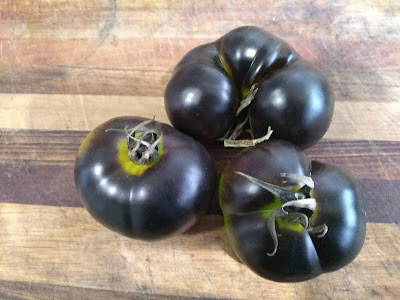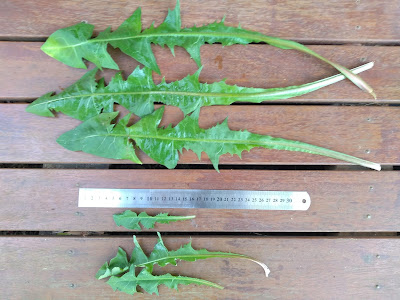I used to look at online plant shops at all the plants they had that were claimed to be 'exclusives'. That used to impress me. Then, one day one of these places bought plants from me and started selling them as exclusives. One of these places talks about saving heirloom vegetables, yet often renames things and then claims that they are exclusive to them. I am no longer impressed in the slightest when I see claims of plants or seeds as being exclusive.
Very few online plant shops carry things that they have developed themselves. I am far more impressed by this as breeding a new variety takes years of dedication.
I breed new vegetable varieties, and improved herb varieties, and berry varieties, and fruit varieties etc myself. Some are listed below while others are not yet stable enough to list here. Some are named, while others still need to be named. Maybe I should have a competition of some sort one day to name some of my new things.
Some of them are for sale through my for sale page, while others are not for sale yet. Everything I grow is organic, I don't even use the poisons that are certified to be used in organic farms.
Original Vegetables developed by Living-Mudflower
Igloo tomato
'Igloo' tomatoes were the first tomatoes I ever bred. I had limited access to germplasm, at the time I was young with only a rudimentary understanding of genetics and no one to guide me, yet I was still able to get a great end result.
Igloo tomatoes are short stout little plants
somewhere between one and two feet tall, small red round tomatoes that are very uniform in size and colour. They normally taste ok but it tastes far superior if left to fully ripen. Large seeds make seed saving simple. Great for
small spaces or short seasons as it is one of the first to ripen and
produces over a long period, and they are incredibly high yielding
usually producing 10kg to 12kg of tomatoes per plant in my garden. That is a tremendous amount of tomatoes for such a small plant.
 |
| Igloo tomato |
Nanuq tomato
'Nanuq' was another of the first tomatoes I bred back when I was very young. Small
wimpy looking but surprisingly strong plants, small red round tomatoes
produced on plants that are about a foot tall. These have wispy carrot like foliage that were bred for taste and early ripening. Nanuq tomatoes are one of the
first tomatoes to ripen and only takes up a little space. I’m not blown away by
the size of the crop but it makes up for that with the taste.
 |
| Nanuq tomato |
Immali corn
'Immali' corn is a pink/purple and white sweet corn. I believe this
is the first purple sweet corn to have been developed in Australia. This purple
sweet corn is healthier than yellow corn as it is high in antioxidants, and better tasting than any
store bought corn. Reasonably short plants around 5 feet tall, most
tiller to some extent, they produces numerous cobs per plant but is highly dependent on
spacing and soil fertility. Sweet corn with su se+ genes means it is
best suited for backyards rather than market gardens as cobs don’t store
anywhere near as long as the Sh2 varieties, but they have a superior taste.
 |
| Immali corn - purple sweet corn |
 |
| Immali corn - dry seeds for saving |
Amiah potato (pronounced 'uh-my-uh')
In my opinion 'Amiah' potatoes are the best of the best of diploid potatoes. They have the great taste of a diploid potato without having the low yields that are common among diploids. The size of potatoes is small but reasonable, they don’t need peeling, and each plant produces crops that are good but not as large as many tetraploid varieties. Amiah potatoes are healthier to eat and better looking than white potatoes due to its rich yellow flesh and interesting skin colour.
Amiah potatoes have a great taste, easily produce two crops per
year here, are quite stubborn/aggressive in its spreading, and always
survives over winter in the soil with no care from me. As well as all
this they produce huge numbers of beautiful purple flowers on long stalks held high above the foliage.
 |
| Amiah potato and white tetraploid potato for comparison |
 |
| Amiah potato and white tetraploid |
Oaken (dwarf multiflora) tomatoes
These produce dwarf plants with regular leaf. Flowers are produced in clusters of about 150, but not all of the fruit sets in my garden and many of the flowers fall off. The fruit is small, mostly round, and light orange often with some green stripes. It has a sweet taste and is surprisingly late to ripen for such a small fruited tomato, but once it does ripen it crops until killed by the frosts as it is an indeterminate dwarf tomato. |
| The colour is off in this photo, they are darker orange than this |
 |
| One truss of dwarf multiflora tomato flowers - good luck trying to count them all |
Tracey tomato (black yellow/green)
Tracey tomatoes are the result of a more recent breeding effort, where I had greater understanding of genetics, more access to germplasm, but far less time to put into the endeavor than many of my earlier breeding attempts. The plants produce tasty little tomatoes that are intensely black where sun hits the fruit, yellow/green under the black. Tracey tomato produces the darkest true black tomatoes that I have ever seen. The black is from the high levels of antioxidants, which make this a very healthy tomato to eat. They have green flesh when ripe, and taste incredible. Unripe tomatoes are beautifully purple, similar to an eggplant.
Tracey tomatoes are very productive, producing mostly round ping pong sized fruit, but are not completely uniform and never will be. This variety has produced well for me in hot dry summers, in mild wet summers, in dust storms, through drought, as well as during lovely mild years. Ornamental, highly productive, with great taste makes these a great variety to grow.
 | ||
Ripe Black Yellow/Green tomatoes
|
Unnamed things
Thornless Primocane Raspberry
This is a dual cropping,
thornless, red raspberry. This variety is sweeter than many red raspberries and
is always completely thornless. The berries don't crumble, and ripe
berries are easily and cleanly removed from the plant. Each plant is
very productive, they can produce several dozen flowers per cluster. Not all berries ripen at once, some berries are ready while some flowers in the same cluster are yet
to open, meaning that harvest is over an extended period. It produces
two or more crops per year and being a thornless primocane variety means
pruning is simple. All of these traits make it an excellent variety to grow in back yards.
 |
| Thornless primocane raspberry - highly productive |
Giant edible dandelion
I can’t remember why I started to breed dandelions, it was a lot more work than it ought to be, and the end result is rather impressive. They are much like normal dandelions you find in your lawn, but bigger in every way. Every part is edible and useful, only bigger and better.
Giant edible dandelions produce longer and wider leaves, larger yellow flowers
on longer fatter stalks, it also has deeper fatter roots. These won't escape into your lawn as they are so large that they need extra water, they are also strangely susceptible to disease and pests.
 |
| Giant dandelion - 30cm ruler and leaves of regular plant for scale |
Massive parsley
The leaves are absolutely massive and have the strong taste that is common among flat leaf parsleys. The leaf stalks (petioles) are so huge that they can be used in the place of celery. The roots do fork a bit, and sometimes have a woody core, but are large and taste incredible roasted (as most parsley roots do).
This is not yet a stable variety as it still produces a range of plants from large to massive. Some plants produce large round leaves, but this trait is uncommon (even when self-pollinated) and may disappear from this variety. I have mostly stopped growing this because it got too large. It is too bad, I really enjoyed the look of absurdly large parsley plants.
 |
| Massive parsley leaf - 30cm ruler and leaf of regular plant |
Improved coriander
I love coriander. Far too often coriander is bred only using selection, and very rarely through crossing different varieties. This is not a stable variety, and I am doing my best to ensure that it never will be. I deliberately mass crossed a dozen or so varieties of coriander, some that were bred for leaf production, others for seed production, others were said to be slow bolting. I keep introducing parent varieties, earlier generations, and other improved varieties. The result is a highly genetically diverse population of mostly large leaf, large seed, and slow bolting coriander. Most have the usual white coriander flowers, but some have pink/red stems and flowers. When you grow this you cull anything that flowers early and you quickly establish a variety that is slow bolting in your garden.
 |
| Coriander leaf |
 |
| I can't get enough coriander |
I really should add to this list in the future. I have a lot of breeding lines, some are almost stable while others are still segregating.
I also have a few lines of spring bulbs and other ornamental plants that I have bred, perhaps I should add them in here too. Or maybe they deserve their own blog post?






